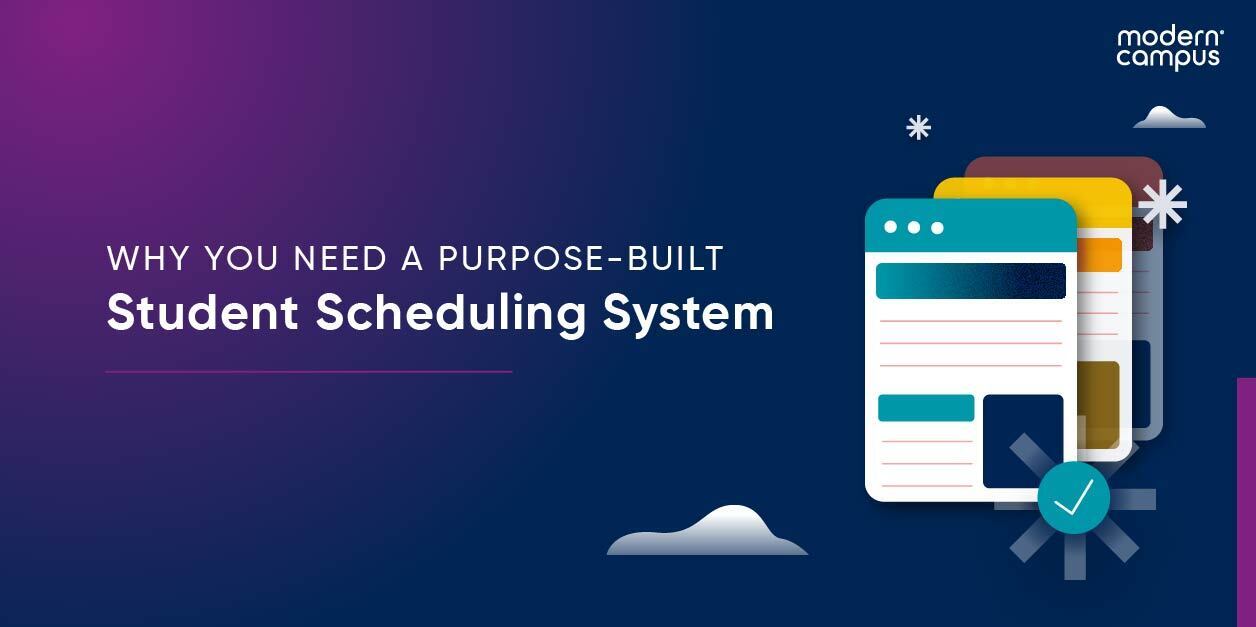9 Registration Functions Your Higher Ed SIS Can’t Do
Modern students, most of whom are Gen Z, are digital natives – they’ve grown up online and are accustomed to immediacy and automation. So, it’s no wonder that students are frustrated with the registration process at their institution. Time conflicts, the inability to find seats in the right classes and location restrictions are but a few of the common frustrations that students experience over and over again when trying to register.
Colleges and universities that use Excel sheets or their Student Information Systems (SIS) to build student schedules not only leave their students frustrated with the registration experience, but they also make it difficult for the staff to create schedules. Department schedulers have to remember time blocks, meeting patterns, instructor preferences, assigned teaching faculty, credit hours, release hours and more.
Fortunately, an intelligent student scheduling system that’s purpose-built for higher ed can turn frustration into opportunity. Using algorithmic scheduling, such a system delivers the registration experience that students expect, and the staff deserves. It creates smart schedules based on monitoring student search and enrollment activities, including course supply and anticipated demand. It accounts for common course conflicts and provides student persistence and enrollment heat maps. On top of all that, it is quick and simple to use.
Here are nine critical registration functions that a smart student scheduling system allows you to do, which a spreadsheet or SIS does not.
1. Create Schedules Instantly Using Automated Mathematical Algorithms
Colleges and universities lay out academic pathways with required classes. Students find it highly frustrating when they can’t get into the classes they need. Unfortunately, this is the experience many students have each time they begin the registration process.
However, an algorithmic registration planner platform reduces the entire registration process to 10-to-15 minutes. It automatically pulls the course descriptions, prerequisites, and living seating data required to create a set schedule from the SIS and creates schedules tailored to each student’s needs.
2. Identify Classes Based on Time Preferences and Constraints
Work, childcare and other personal responsibilities often dictate when students can attend classes. Quality student class scheduling software takes these time preferences into consideration when generating a schedule.
It also makes it easy to block time by allowing students to simply drag and drop work and personal schedules into the student scheduler. If, for example, a student works every afternoon or if they don’t want early morning classes, they can block out those times and sort classes accordingly.
3. Select Classes Based on Personalized Filters
Time and course requisites aren’t the only scheduling considerations. Students often want to filter classes by professor, class type or specific department. An intelligent student class scheduling software makes it easy to narrow class selection based on specific parameters like these.
4. Build In Scheduled Commute Times Using Geolocation Data
Creating schedules based on filters and available classes is not the only thing that a scheduling solution can do. An intelligent student scheduler that considers commute times when scheduling classes takes student registration to a whole new level.
A schedule in which classes fit together well timewise would not be a practical one if those classes are located far across campus or at different campus entirely. Distant locations cause students to hustle. They’ likely to arrive late or incur parking tickets. Student-centric scheduling software prevents unneeded stressful situations by building in commute times to schedules.
5. Collaborate and Share Results with Friends, Families and Advisors
Students don’t complete their schedules in a bubble. They want input from their families, guidance from advisors and classes with friends. A student schedule builder purpose-built for higher ed makes these types of collaboration not only possible but easy.
As an added bonus, students consulting with parents and peers dramatically lowers the volume of user questions and support calls. Learners can share their schedules, get the help they need, and then edit and control their own schedules in self-service without manual staff support.
6. Sort Schedule Options on Certain Criteria
Students have all kinds of unique wants and needs, and quality enrollment management should be able to accommodate them with ease.
For instance, one of the top challenges campuses are facing today is accessibility. When a university experience is truly accessible, it provides an equal experience for students of all abilities. This means that any barriers facing students should be taken into account in all aspects of campus life—including scheduling.
A student scheduler with accessibility considerations built in includes features to remove barriers. For example, it allows students to sort classes based on accessibility criteria such as physical locations and accessible ramps or even class spaces that make accommodations for visual impairment. Addressing these crucial needs is a hallmark of a flexible, comprehensive schedule planning system.
7. Single-Click Adds, Drops and Swaps for Tailor-Made Class Schedules
Most student registration management systems require students to map out their schedule on paper, then fill in their classes one by one online. When they encounter a class section that’s full, they must backtrack, review alternate class dates, and start over by adding, dropping and swapping until they hopefully get the classes they need on their calendar.
With a quality student scheduler, students can simply determine the classes they need, specify available times and let the scheduling system do the work. When a registration management system is built with students in mind, it performs adds, drops and swaps in a single click, so students finalize the schedule they want and need quickly.
8. Allow Advisors and Administrators to Collaborate with Students and Lock in Specific Courses or Sections
Student centricity shouldn’t come at the cost of positive staff experiences. While students should always be the main focus for a student information system, there should also be advantages for advisors and staff across the registrar’s office. A quality student scheduling system allows advisors to collaborate with students and set aside specific courses or sections for a particular student population.
For example, if first-year biology students are required to take Biology 1, an advisor can set parameters on specific sections and even courses to ensure there are enough seats for all first-year biology majors. Advisors can specify a specific class or provide flexibility by locking students into a section with the same class at different times.
9. Monitor Preregistration Search and Demand Data Before Registration Begins
The best registration management systems should be able to generate reports based on past and present course demand data to help registrars and administrators anticipate future demand.
This gives colleges and universities a real advantage because they’ll know ahead of time which classes students need, plus when and where they tend to take those classes. With valuable data like this at your fingertips, you can make continuous improvements to the process, benefiting both students and administrators.
When a registration scheduling system simplifies the process and helps students find and fit in the classes they need, your college or university can capitalize on never-before-realized tuition revenue and students benefit from a hyper-focused student-centric experience.
Want to deliver modern registration experience to your students?
In a world where students are accustomed to attentive service, it makes sense to provide them with a smarter scheduling option that intuitively keeps them on track for graduation. As a bonus, a quality student scheduling system also streamlines workflow for registration administrators. But don’t take our word for it—see why two million students enjoy registering with Modern Campus Navigate. Request a demo today!
Florida A&M University Increases Student Persistence and Retention
How a top-ranked university leverages Modern Campus Navigate to improve student enrollment and advising
Last updated: October 31, 2023




